HRM Report: Analysis of Recruitment and Selection Policies
VerifiedAdded on 2022/12/02
|12
|2795
|332
Report
AI Summary
This report analyzes the 2000 and 2016 Healthcare United Recruitment Selection Policies, highlighting key areas for improvement and best practices in recruitment and selection processes. It examines the evolution of these policies, comparing outdated methods with current research and legislation compliance. The report outlines the development of recruitment and selection procedures, including vacant position analysis, position descriptions, advertising, shortlisting, interviewing, reference checks, and job offers. It also details a comprehensive communication plan and discusses meetings with assessors, policy and procedure training, and answers to questions related to recruitment methods, outsourcing, employee contracts, and relevant legislation. The report emphasizes the importance of technology in modern recruitment and the need for continuous training and development to ensure effective and ethical hiring practices.
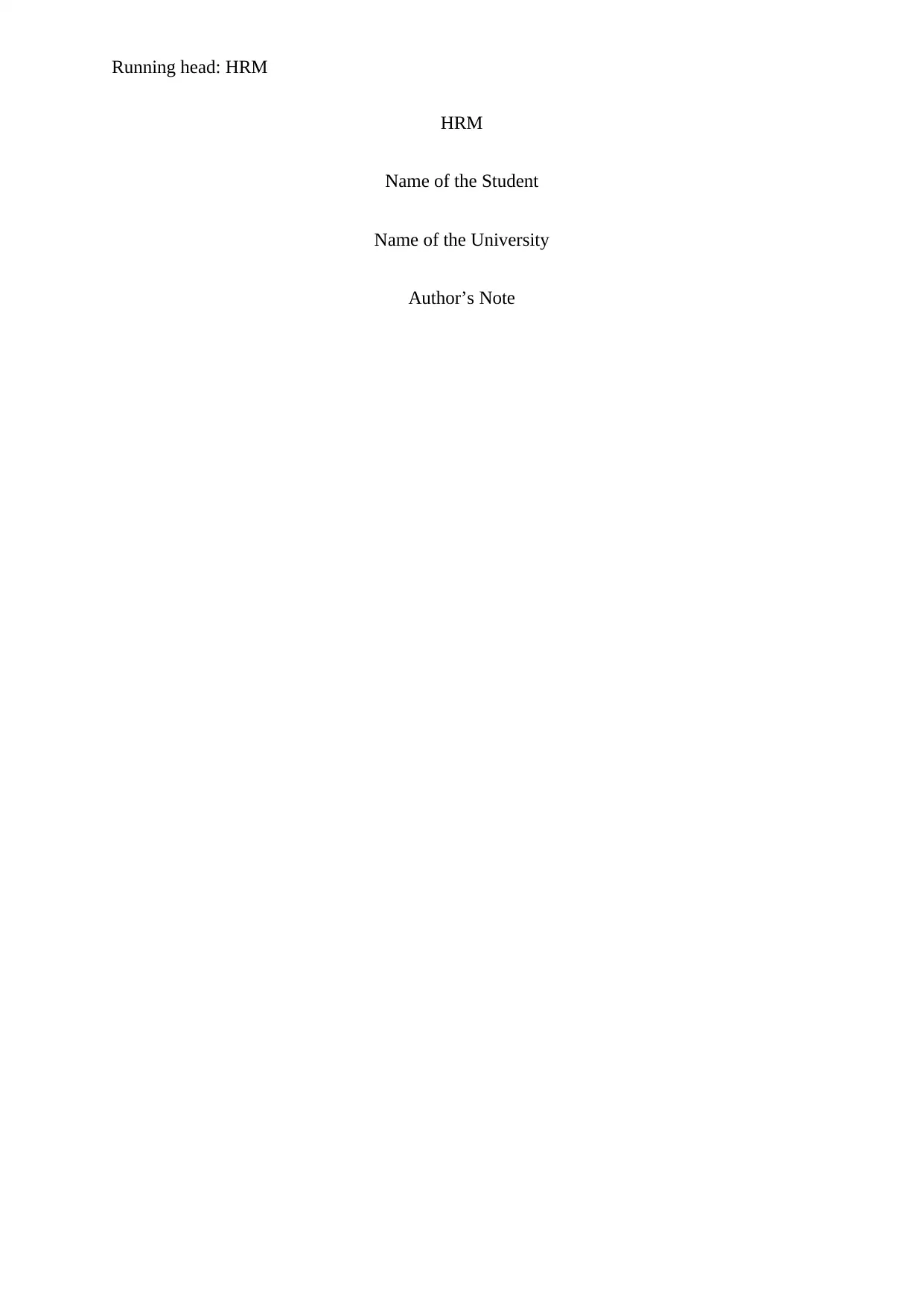
Running head: HRM
HRM
Name of the Student
Name of the University
Author’s Note
HRM
Name of the Student
Name of the University
Author’s Note
Paraphrase This Document
Need a fresh take? Get an instant paraphrase of this document with our AI Paraphraser
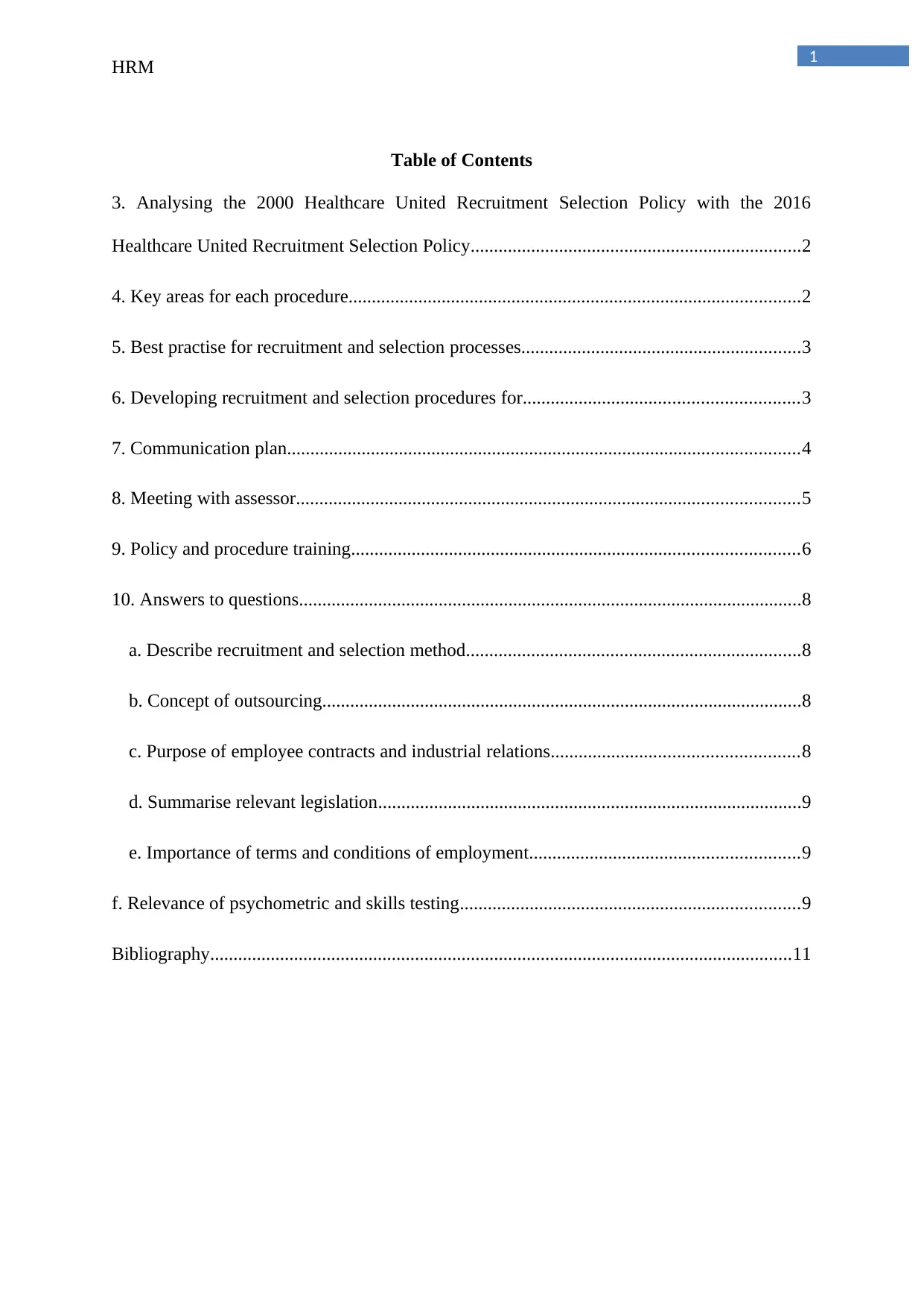
1
HRM
Table of Contents
3. Analysing the 2000 Healthcare United Recruitment Selection Policy with the 2016
Healthcare United Recruitment Selection Policy.......................................................................2
4. Key areas for each procedure.................................................................................................2
5. Best practise for recruitment and selection processes............................................................3
6. Developing recruitment and selection procedures for...........................................................3
7. Communication plan..............................................................................................................4
8. Meeting with assessor............................................................................................................5
9. Policy and procedure training................................................................................................6
10. Answers to questions............................................................................................................8
a. Describe recruitment and selection method........................................................................8
b. Concept of outsourcing.......................................................................................................8
c. Purpose of employee contracts and industrial relations.....................................................8
d. Summarise relevant legislation...........................................................................................9
e. Importance of terms and conditions of employment..........................................................9
f. Relevance of psychometric and skills testing.........................................................................9
Bibliography.............................................................................................................................11
HRM
Table of Contents
3. Analysing the 2000 Healthcare United Recruitment Selection Policy with the 2016
Healthcare United Recruitment Selection Policy.......................................................................2
4. Key areas for each procedure.................................................................................................2
5. Best practise for recruitment and selection processes............................................................3
6. Developing recruitment and selection procedures for...........................................................3
7. Communication plan..............................................................................................................4
8. Meeting with assessor............................................................................................................5
9. Policy and procedure training................................................................................................6
10. Answers to questions............................................................................................................8
a. Describe recruitment and selection method........................................................................8
b. Concept of outsourcing.......................................................................................................8
c. Purpose of employee contracts and industrial relations.....................................................8
d. Summarise relevant legislation...........................................................................................9
e. Importance of terms and conditions of employment..........................................................9
f. Relevance of psychometric and skills testing.........................................................................9
Bibliography.............................................................................................................................11

2
HRM
3. Analysing the 2000 Healthcare United Recruitment Selection Policy with the 2016
Healthcare United Recruitment Selection Policy
The 2000 Healthcare United Recruitment Selection Policy provides evidence about
the manner in which facilities and procedures that exist in a competitive environment. With
the development of modern facilities and technologies in the health care sectors, it is
necessary to develop facilities that can aid the people. The 2016 Healthcare United
Recruitment Selection Policy provides emphasis on the facilities that are to be developed so
that competitive advantage can be derived. At the same time, the key recruitment to selection
is provided in the 2016 Healthcare United Recruitment Selection Policy.
4. Key areas for each procedure
Contrary to 2016 policies: The key areas that can be identified in the procedures are
the manner in which recruitment and selection process has improved. At the same
time, the assumption of responsibilities by the managers is also an important factor
that has led to the development of the 2016 policies.
Outdated compared to current research and practise: The outdated procedure is the
manner in which recruitment of talented individuals are made via only the interview
method. In the current research and practise, analysis of vacant position in
organisations is done and based on the analysis suitable recruitment of people are
undertaken.
Do not comply with current legislation: The current procedure can comply with the
legislation based on the recruitment and selection undertaken by the organisations. It
is necessary to ensure that the current practises comply with the recent legislation of
the country.
HRM
3. Analysing the 2000 Healthcare United Recruitment Selection Policy with the 2016
Healthcare United Recruitment Selection Policy
The 2000 Healthcare United Recruitment Selection Policy provides evidence about
the manner in which facilities and procedures that exist in a competitive environment. With
the development of modern facilities and technologies in the health care sectors, it is
necessary to develop facilities that can aid the people. The 2016 Healthcare United
Recruitment Selection Policy provides emphasis on the facilities that are to be developed so
that competitive advantage can be derived. At the same time, the key recruitment to selection
is provided in the 2016 Healthcare United Recruitment Selection Policy.
4. Key areas for each procedure
Contrary to 2016 policies: The key areas that can be identified in the procedures are
the manner in which recruitment and selection process has improved. At the same
time, the assumption of responsibilities by the managers is also an important factor
that has led to the development of the 2016 policies.
Outdated compared to current research and practise: The outdated procedure is the
manner in which recruitment of talented individuals are made via only the interview
method. In the current research and practise, analysis of vacant position in
organisations is done and based on the analysis suitable recruitment of people are
undertaken.
Do not comply with current legislation: The current procedure can comply with the
legislation based on the recruitment and selection undertaken by the organisations. It
is necessary to ensure that the current practises comply with the recent legislation of
the country.
⊘ This is a preview!⊘
Do you want full access?
Subscribe today to unlock all pages.

Trusted by 1+ million students worldwide
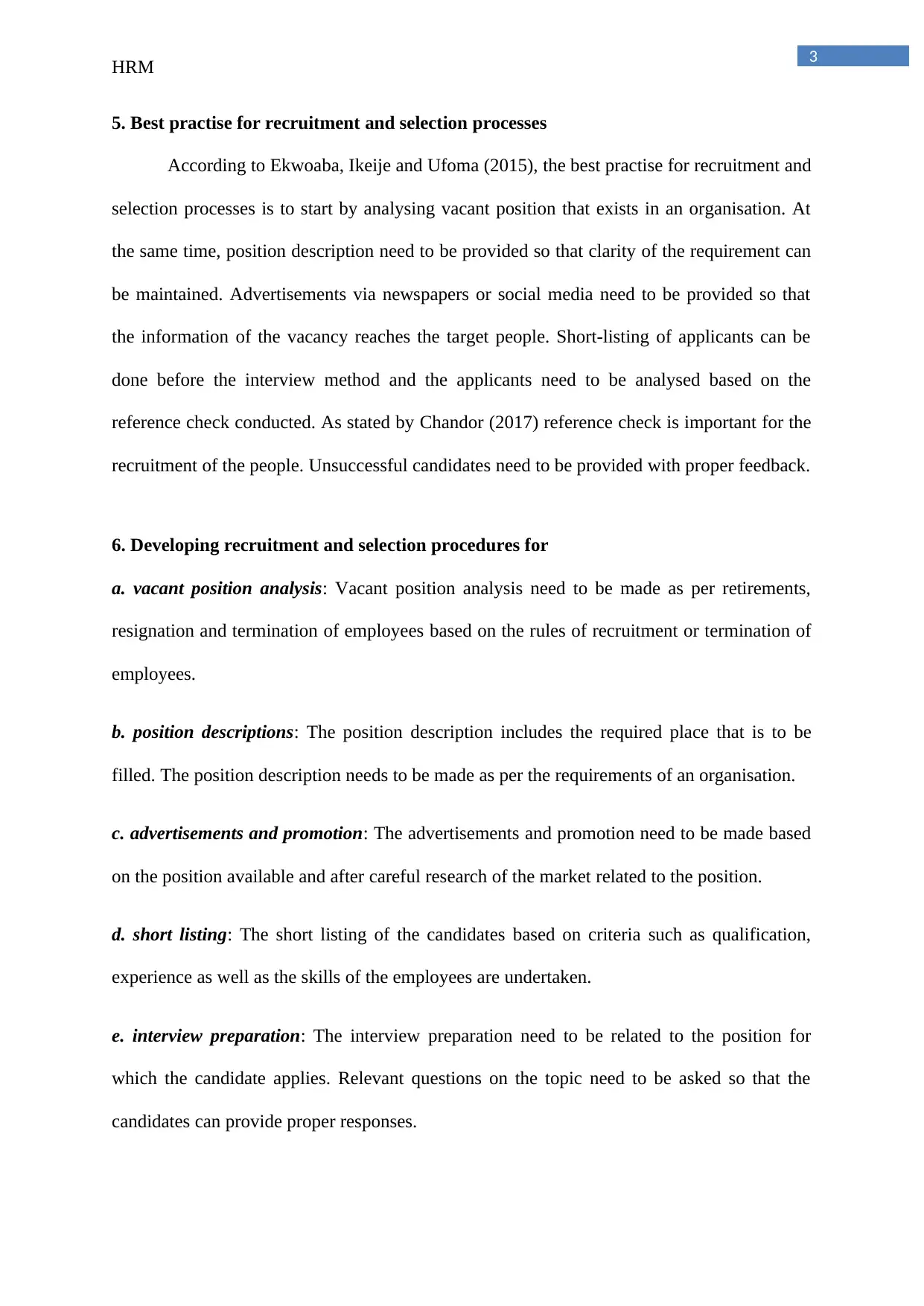
3
HRM
5. Best practise for recruitment and selection processes
According to Ekwoaba, Ikeije and Ufoma (2015), the best practise for recruitment and
selection processes is to start by analysing vacant position that exists in an organisation. At
the same time, position description need to be provided so that clarity of the requirement can
be maintained. Advertisements via newspapers or social media need to be provided so that
the information of the vacancy reaches the target people. Short-listing of applicants can be
done before the interview method and the applicants need to be analysed based on the
reference check conducted. As stated by Chandor (2017) reference check is important for the
recruitment of the people. Unsuccessful candidates need to be provided with proper feedback.
6. Developing recruitment and selection procedures for
a. vacant position analysis: Vacant position analysis need to be made as per retirements,
resignation and termination of employees based on the rules of recruitment or termination of
employees.
b. position descriptions: The position description includes the required place that is to be
filled. The position description needs to be made as per the requirements of an organisation.
c. advertisements and promotion: The advertisements and promotion need to be made based
on the position available and after careful research of the market related to the position.
d. short listing: The short listing of the candidates based on criteria such as qualification,
experience as well as the skills of the employees are undertaken.
e. interview preparation: The interview preparation need to be related to the position for
which the candidate applies. Relevant questions on the topic need to be asked so that the
candidates can provide proper responses.
HRM
5. Best practise for recruitment and selection processes
According to Ekwoaba, Ikeije and Ufoma (2015), the best practise for recruitment and
selection processes is to start by analysing vacant position that exists in an organisation. At
the same time, position description need to be provided so that clarity of the requirement can
be maintained. Advertisements via newspapers or social media need to be provided so that
the information of the vacancy reaches the target people. Short-listing of applicants can be
done before the interview method and the applicants need to be analysed based on the
reference check conducted. As stated by Chandor (2017) reference check is important for the
recruitment of the people. Unsuccessful candidates need to be provided with proper feedback.
6. Developing recruitment and selection procedures for
a. vacant position analysis: Vacant position analysis need to be made as per retirements,
resignation and termination of employees based on the rules of recruitment or termination of
employees.
b. position descriptions: The position description includes the required place that is to be
filled. The position description needs to be made as per the requirements of an organisation.
c. advertisements and promotion: The advertisements and promotion need to be made based
on the position available and after careful research of the market related to the position.
d. short listing: The short listing of the candidates based on criteria such as qualification,
experience as well as the skills of the employees are undertaken.
e. interview preparation: The interview preparation need to be related to the position for
which the candidate applies. Relevant questions on the topic need to be asked so that the
candidates can provide proper responses.
Paraphrase This Document
Need a fresh take? Get an instant paraphrase of this document with our AI Paraphraser
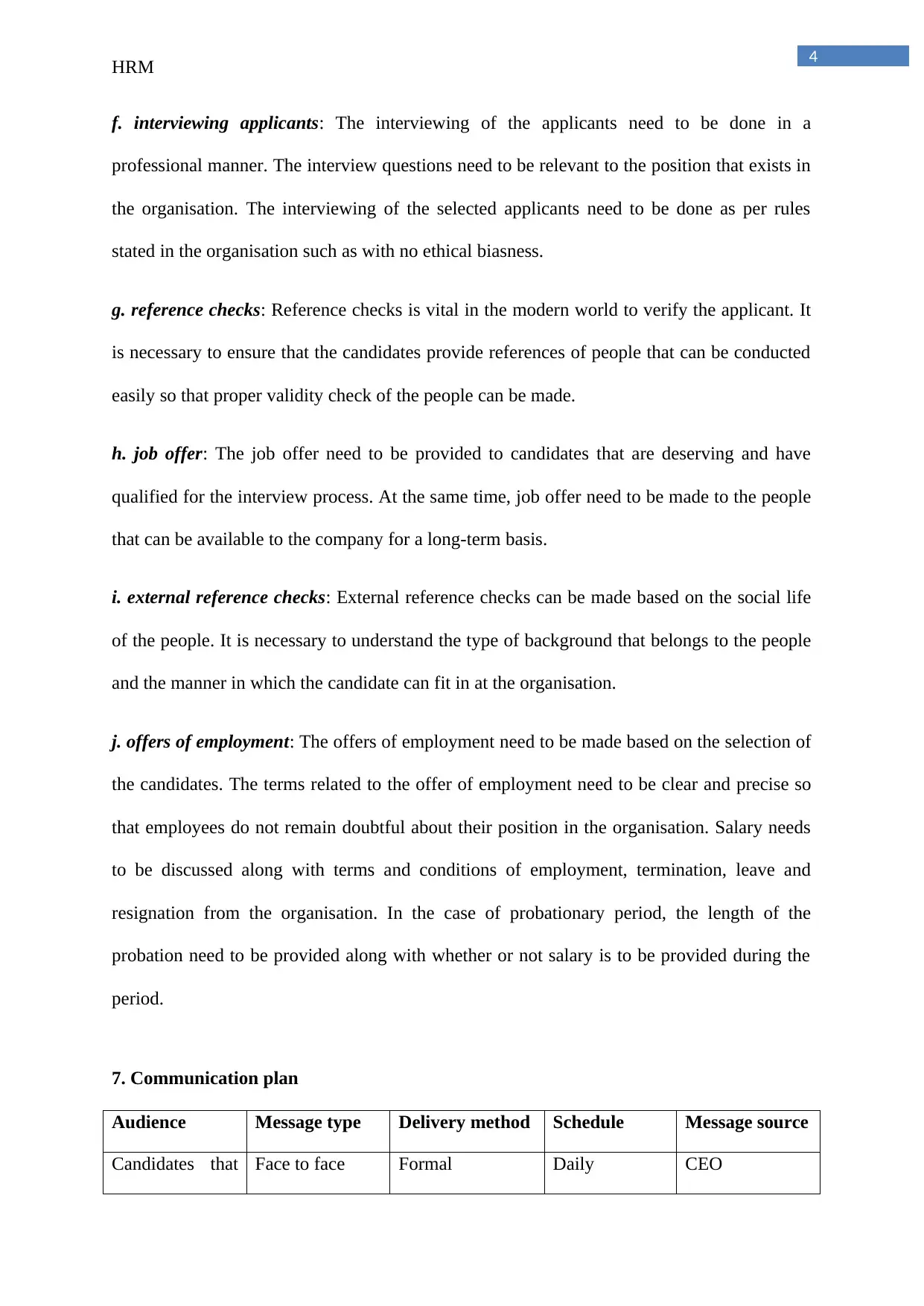
4
HRM
f. interviewing applicants: The interviewing of the applicants need to be done in a
professional manner. The interview questions need to be relevant to the position that exists in
the organisation. The interviewing of the selected applicants need to be done as per rules
stated in the organisation such as with no ethical biasness.
g. reference checks: Reference checks is vital in the modern world to verify the applicant. It
is necessary to ensure that the candidates provide references of people that can be conducted
easily so that proper validity check of the people can be made.
h. job offer: The job offer need to be provided to candidates that are deserving and have
qualified for the interview process. At the same time, job offer need to be made to the people
that can be available to the company for a long-term basis.
i. external reference checks: External reference checks can be made based on the social life
of the people. It is necessary to understand the type of background that belongs to the people
and the manner in which the candidate can fit in at the organisation.
j. offers of employment: The offers of employment need to be made based on the selection of
the candidates. The terms related to the offer of employment need to be clear and precise so
that employees do not remain doubtful about their position in the organisation. Salary needs
to be discussed along with terms and conditions of employment, termination, leave and
resignation from the organisation. In the case of probationary period, the length of the
probation need to be provided along with whether or not salary is to be provided during the
period.
7. Communication plan
Audience Message type Delivery method Schedule Message source
Candidates that Face to face Formal Daily CEO
HRM
f. interviewing applicants: The interviewing of the applicants need to be done in a
professional manner. The interview questions need to be relevant to the position that exists in
the organisation. The interviewing of the selected applicants need to be done as per rules
stated in the organisation such as with no ethical biasness.
g. reference checks: Reference checks is vital in the modern world to verify the applicant. It
is necessary to ensure that the candidates provide references of people that can be conducted
easily so that proper validity check of the people can be made.
h. job offer: The job offer need to be provided to candidates that are deserving and have
qualified for the interview process. At the same time, job offer need to be made to the people
that can be available to the company for a long-term basis.
i. external reference checks: External reference checks can be made based on the social life
of the people. It is necessary to understand the type of background that belongs to the people
and the manner in which the candidate can fit in at the organisation.
j. offers of employment: The offers of employment need to be made based on the selection of
the candidates. The terms related to the offer of employment need to be clear and precise so
that employees do not remain doubtful about their position in the organisation. Salary needs
to be discussed along with terms and conditions of employment, termination, leave and
resignation from the organisation. In the case of probationary period, the length of the
probation need to be provided along with whether or not salary is to be provided during the
period.
7. Communication plan
Audience Message type Delivery method Schedule Message source
Candidates that Face to face Formal Daily CEO
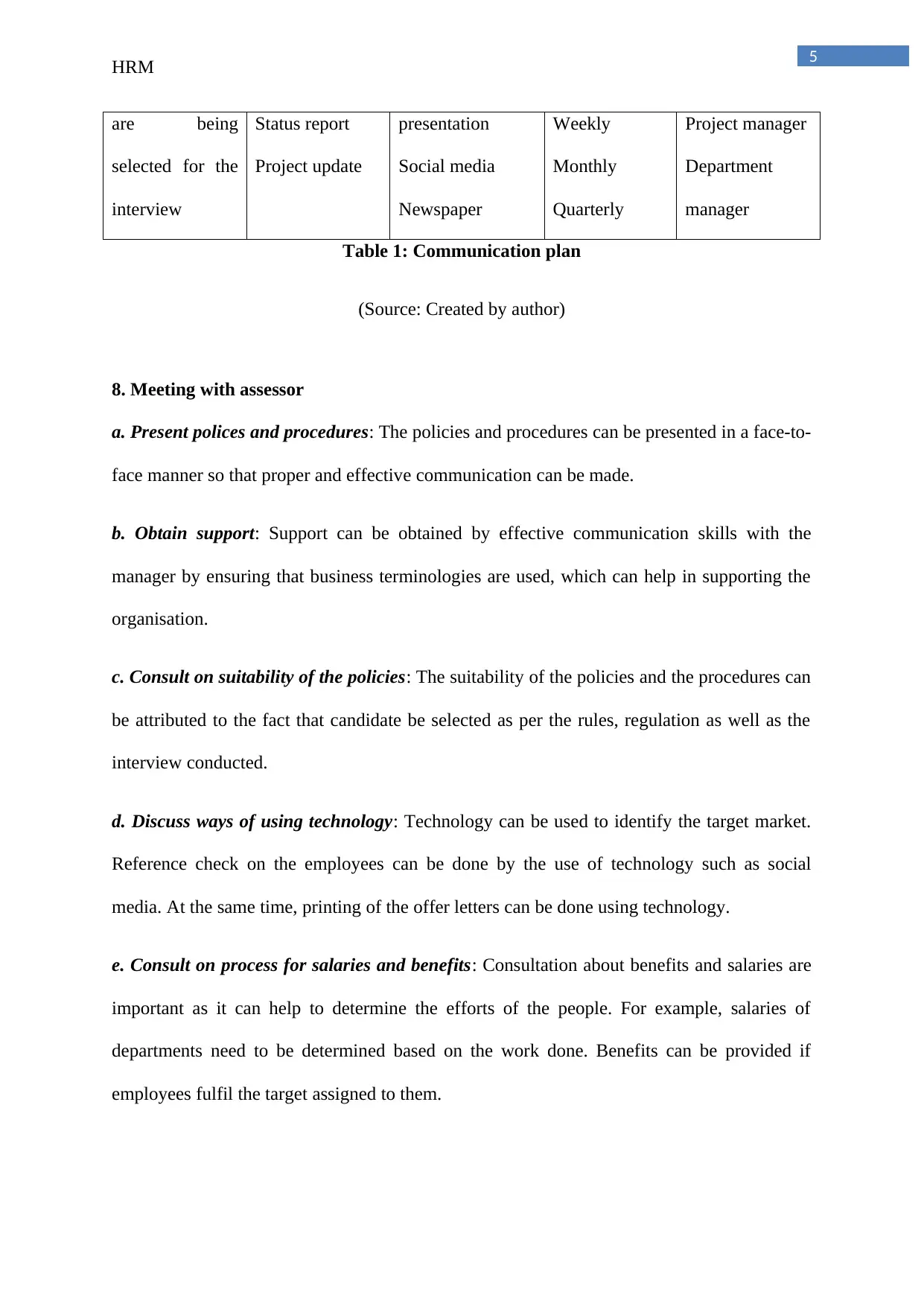
5
HRM
are being
selected for the
interview
Status report
Project update
presentation
Social media
Newspaper
Weekly
Monthly
Quarterly
Project manager
Department
manager
Table 1: Communication plan
(Source: Created by author)
8. Meeting with assessor
a. Present polices and procedures: The policies and procedures can be presented in a face-to-
face manner so that proper and effective communication can be made.
b. Obtain support: Support can be obtained by effective communication skills with the
manager by ensuring that business terminologies are used, which can help in supporting the
organisation.
c. Consult on suitability of the policies: The suitability of the policies and the procedures can
be attributed to the fact that candidate be selected as per the rules, regulation as well as the
interview conducted.
d. Discuss ways of using technology: Technology can be used to identify the target market.
Reference check on the employees can be done by the use of technology such as social
media. At the same time, printing of the offer letters can be done using technology.
e. Consult on process for salaries and benefits: Consultation about benefits and salaries are
important as it can help to determine the efforts of the people. For example, salaries of
departments need to be determined based on the work done. Benefits can be provided if
employees fulfil the target assigned to them.
HRM
are being
selected for the
interview
Status report
Project update
presentation
Social media
Newspaper
Weekly
Monthly
Quarterly
Project manager
Department
manager
Table 1: Communication plan
(Source: Created by author)
8. Meeting with assessor
a. Present polices and procedures: The policies and procedures can be presented in a face-to-
face manner so that proper and effective communication can be made.
b. Obtain support: Support can be obtained by effective communication skills with the
manager by ensuring that business terminologies are used, which can help in supporting the
organisation.
c. Consult on suitability of the policies: The suitability of the policies and the procedures can
be attributed to the fact that candidate be selected as per the rules, regulation as well as the
interview conducted.
d. Discuss ways of using technology: Technology can be used to identify the target market.
Reference check on the employees can be done by the use of technology such as social
media. At the same time, printing of the offer letters can be done using technology.
e. Consult on process for salaries and benefits: Consultation about benefits and salaries are
important as it can help to determine the efforts of the people. For example, salaries of
departments need to be determined based on the work done. Benefits can be provided if
employees fulfil the target assigned to them.
⊘ This is a preview!⊘
Do you want full access?
Subscribe today to unlock all pages.

Trusted by 1+ million students worldwide
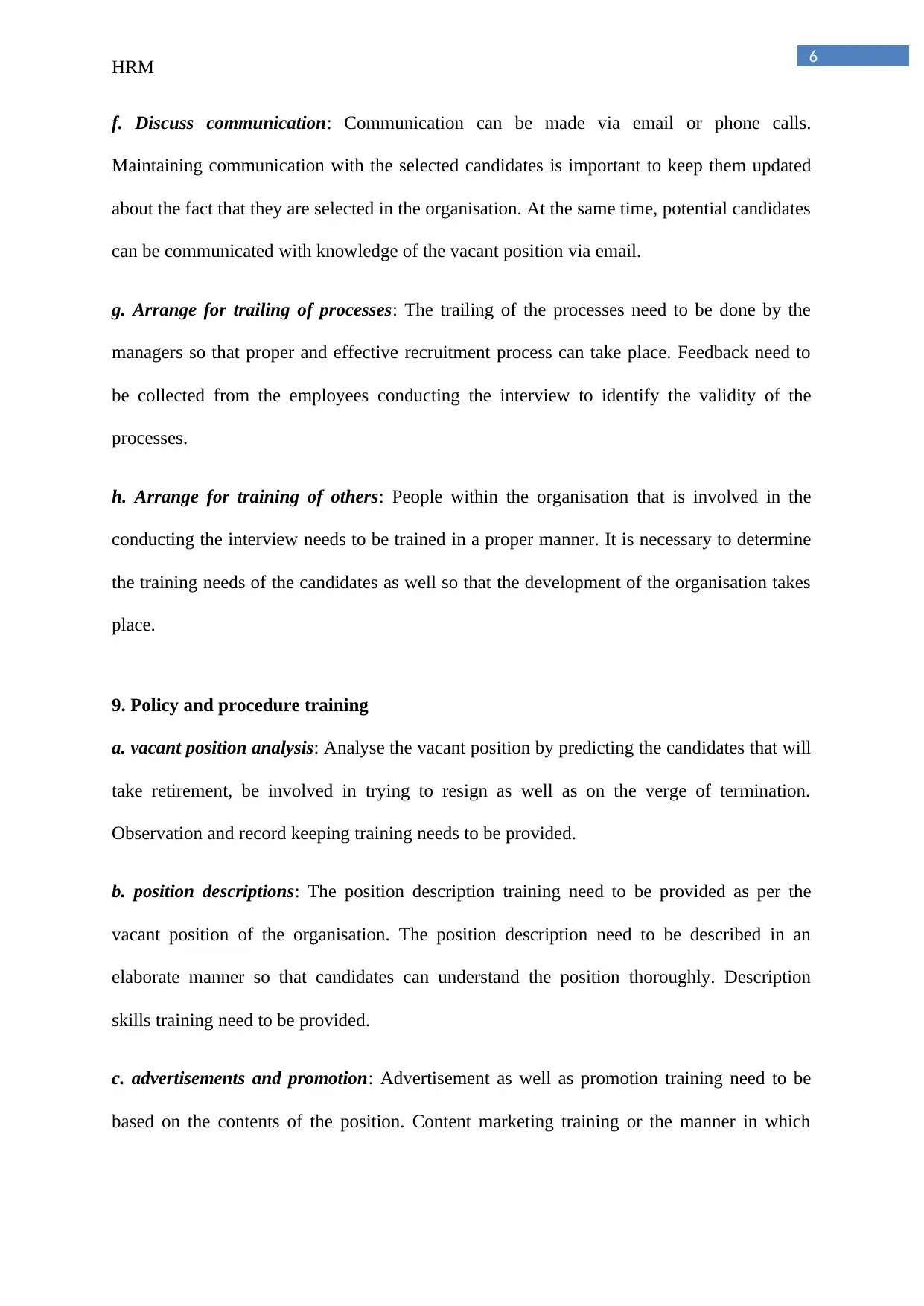
6
HRM
f. Discuss communication: Communication can be made via email or phone calls.
Maintaining communication with the selected candidates is important to keep them updated
about the fact that they are selected in the organisation. At the same time, potential candidates
can be communicated with knowledge of the vacant position via email.
g. Arrange for trailing of processes: The trailing of the processes need to be done by the
managers so that proper and effective recruitment process can take place. Feedback need to
be collected from the employees conducting the interview to identify the validity of the
processes.
h. Arrange for training of others: People within the organisation that is involved in the
conducting the interview needs to be trained in a proper manner. It is necessary to determine
the training needs of the candidates as well so that the development of the organisation takes
place.
9. Policy and procedure training
a. vacant position analysis: Analyse the vacant position by predicting the candidates that will
take retirement, be involved in trying to resign as well as on the verge of termination.
Observation and record keeping training needs to be provided.
b. position descriptions: The position description training need to be provided as per the
vacant position of the organisation. The position description need to be described in an
elaborate manner so that candidates can understand the position thoroughly. Description
skills training need to be provided.
c. advertisements and promotion: Advertisement as well as promotion training need to be
based on the contents of the position. Content marketing training or the manner in which
HRM
f. Discuss communication: Communication can be made via email or phone calls.
Maintaining communication with the selected candidates is important to keep them updated
about the fact that they are selected in the organisation. At the same time, potential candidates
can be communicated with knowledge of the vacant position via email.
g. Arrange for trailing of processes: The trailing of the processes need to be done by the
managers so that proper and effective recruitment process can take place. Feedback need to
be collected from the employees conducting the interview to identify the validity of the
processes.
h. Arrange for training of others: People within the organisation that is involved in the
conducting the interview needs to be trained in a proper manner. It is necessary to determine
the training needs of the candidates as well so that the development of the organisation takes
place.
9. Policy and procedure training
a. vacant position analysis: Analyse the vacant position by predicting the candidates that will
take retirement, be involved in trying to resign as well as on the verge of termination.
Observation and record keeping training needs to be provided.
b. position descriptions: The position description training need to be provided as per the
vacant position of the organisation. The position description need to be described in an
elaborate manner so that candidates can understand the position thoroughly. Description
skills training need to be provided.
c. advertisements and promotion: Advertisement as well as promotion training need to be
based on the contents of the position. Content marketing training or the manner in which
Paraphrase This Document
Need a fresh take? Get an instant paraphrase of this document with our AI Paraphraser
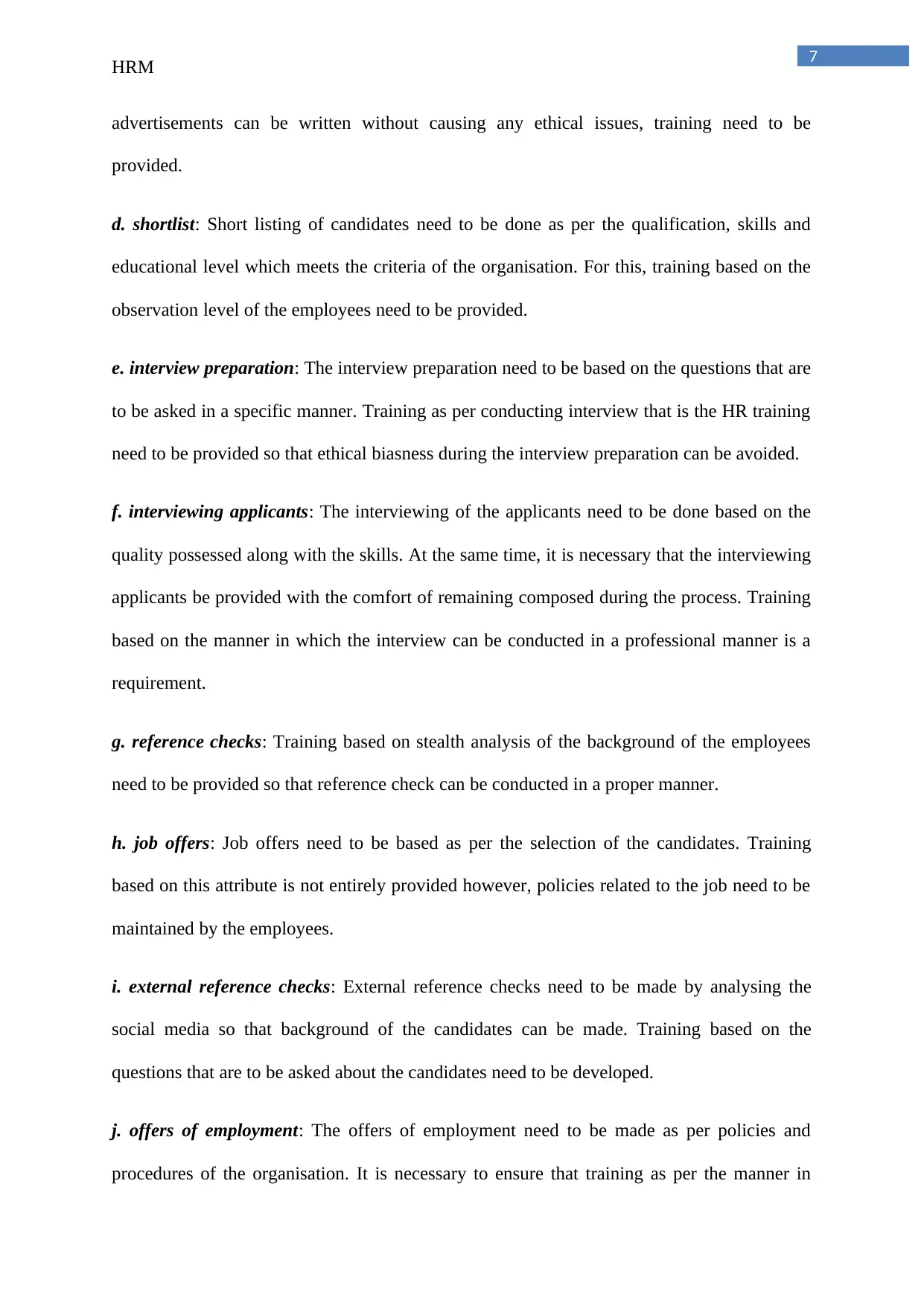
7
HRM
advertisements can be written without causing any ethical issues, training need to be
provided.
d. shortlist: Short listing of candidates need to be done as per the qualification, skills and
educational level which meets the criteria of the organisation. For this, training based on the
observation level of the employees need to be provided.
e. interview preparation: The interview preparation need to be based on the questions that are
to be asked in a specific manner. Training as per conducting interview that is the HR training
need to be provided so that ethical biasness during the interview preparation can be avoided.
f. interviewing applicants: The interviewing of the applicants need to be done based on the
quality possessed along with the skills. At the same time, it is necessary that the interviewing
applicants be provided with the comfort of remaining composed during the process. Training
based on the manner in which the interview can be conducted in a professional manner is a
requirement.
g. reference checks: Training based on stealth analysis of the background of the employees
need to be provided so that reference check can be conducted in a proper manner.
h. job offers: Job offers need to be based as per the selection of the candidates. Training
based on this attribute is not entirely provided however, policies related to the job need to be
maintained by the employees.
i. external reference checks: External reference checks need to be made by analysing the
social media so that background of the candidates can be made. Training based on the
questions that are to be asked about the candidates need to be developed.
j. offers of employment: The offers of employment need to be made as per policies and
procedures of the organisation. It is necessary to ensure that training as per the manner in
HRM
advertisements can be written without causing any ethical issues, training need to be
provided.
d. shortlist: Short listing of candidates need to be done as per the qualification, skills and
educational level which meets the criteria of the organisation. For this, training based on the
observation level of the employees need to be provided.
e. interview preparation: The interview preparation need to be based on the questions that are
to be asked in a specific manner. Training as per conducting interview that is the HR training
need to be provided so that ethical biasness during the interview preparation can be avoided.
f. interviewing applicants: The interviewing of the applicants need to be done based on the
quality possessed along with the skills. At the same time, it is necessary that the interviewing
applicants be provided with the comfort of remaining composed during the process. Training
based on the manner in which the interview can be conducted in a professional manner is a
requirement.
g. reference checks: Training based on stealth analysis of the background of the employees
need to be provided so that reference check can be conducted in a proper manner.
h. job offers: Job offers need to be based as per the selection of the candidates. Training
based on this attribute is not entirely provided however, policies related to the job need to be
maintained by the employees.
i. external reference checks: External reference checks need to be made by analysing the
social media so that background of the candidates can be made. Training based on the
questions that are to be asked about the candidates need to be developed.
j. offers of employment: The offers of employment need to be made as per policies and
procedures of the organisation. It is necessary to ensure that training as per the manner in

8
HRM
which salary need to be made, terms and conditions be set and probation period of the
employees be provided to the people.
10. Answers to questions
a. Describe recruitment and selection method
Recruitment and selection method need to be simple yet effective. The recruitment
and selection method need to be identified the vacant position of the organisation and based
on the position identified. According to Nikolaou and Oostrom (2015), it is necessary to
analyse the manner in which recruitment and selection of potential candidates need to take
place. At the same time, an analysis of the position need to be made which can be described
via advertisement that can help in the development of the candidates. Assessment centres
need to be made so that the recruited or the shortlisted candidates can be scrutinised further
for proper grooming within the organisation.
b. Concept of outsourcing
Outsourcing is the ability to obtain contract or supplies for ensuring hiring of
individuals are done so that a position or organisation can be enhanced. The planned
outsourcing can be done either via an internal process or via an external process. As stated by
Landers and Schmidt (2016) transferring employees and assets form one part of the
organisation to another can be considered as outsourcing.
c. Purpose of employee contracts and industrial relations
The purpose of employee contracts is that the management can legally bond every
employee. The terms and conditions of the employment need to be made in a manner that can
be understood by the employees in a proper manner. dos Santos et al. (2017) stated that the
industrial relations need to be maintained between the employees and the employers. It is
HRM
which salary need to be made, terms and conditions be set and probation period of the
employees be provided to the people.
10. Answers to questions
a. Describe recruitment and selection method
Recruitment and selection method need to be simple yet effective. The recruitment
and selection method need to be identified the vacant position of the organisation and based
on the position identified. According to Nikolaou and Oostrom (2015), it is necessary to
analyse the manner in which recruitment and selection of potential candidates need to take
place. At the same time, an analysis of the position need to be made which can be described
via advertisement that can help in the development of the candidates. Assessment centres
need to be made so that the recruited or the shortlisted candidates can be scrutinised further
for proper grooming within the organisation.
b. Concept of outsourcing
Outsourcing is the ability to obtain contract or supplies for ensuring hiring of
individuals are done so that a position or organisation can be enhanced. The planned
outsourcing can be done either via an internal process or via an external process. As stated by
Landers and Schmidt (2016) transferring employees and assets form one part of the
organisation to another can be considered as outsourcing.
c. Purpose of employee contracts and industrial relations
The purpose of employee contracts is that the management can legally bond every
employee. The terms and conditions of the employment need to be made in a manner that can
be understood by the employees in a proper manner. dos Santos et al. (2017) stated that the
industrial relations need to be maintained between the employees and the employers. It is
⊘ This is a preview!⊘
Do you want full access?
Subscribe today to unlock all pages.

Trusted by 1+ million students worldwide
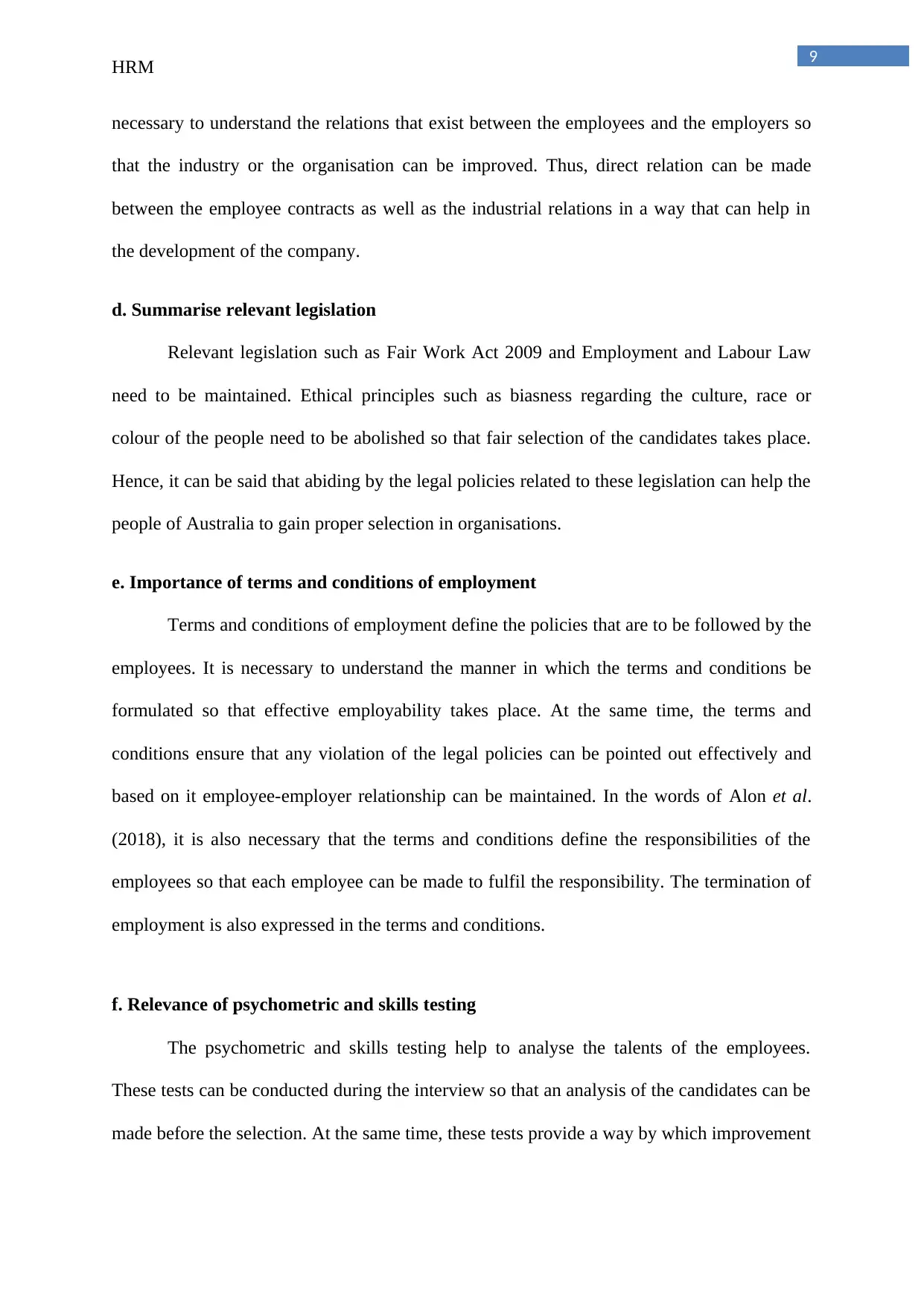
9
HRM
necessary to understand the relations that exist between the employees and the employers so
that the industry or the organisation can be improved. Thus, direct relation can be made
between the employee contracts as well as the industrial relations in a way that can help in
the development of the company.
d. Summarise relevant legislation
Relevant legislation such as Fair Work Act 2009 and Employment and Labour Law
need to be maintained. Ethical principles such as biasness regarding the culture, race or
colour of the people need to be abolished so that fair selection of the candidates takes place.
Hence, it can be said that abiding by the legal policies related to these legislation can help the
people of Australia to gain proper selection in organisations.
e. Importance of terms and conditions of employment
Terms and conditions of employment define the policies that are to be followed by the
employees. It is necessary to understand the manner in which the terms and conditions be
formulated so that effective employability takes place. At the same time, the terms and
conditions ensure that any violation of the legal policies can be pointed out effectively and
based on it employee-employer relationship can be maintained. In the words of Alon et al.
(2018), it is also necessary that the terms and conditions define the responsibilities of the
employees so that each employee can be made to fulfil the responsibility. The termination of
employment is also expressed in the terms and conditions.
f. Relevance of psychometric and skills testing
The psychometric and skills testing help to analyse the talents of the employees.
These tests can be conducted during the interview so that an analysis of the candidates can be
made before the selection. At the same time, these tests provide a way by which improvement
HRM
necessary to understand the relations that exist between the employees and the employers so
that the industry or the organisation can be improved. Thus, direct relation can be made
between the employee contracts as well as the industrial relations in a way that can help in
the development of the company.
d. Summarise relevant legislation
Relevant legislation such as Fair Work Act 2009 and Employment and Labour Law
need to be maintained. Ethical principles such as biasness regarding the culture, race or
colour of the people need to be abolished so that fair selection of the candidates takes place.
Hence, it can be said that abiding by the legal policies related to these legislation can help the
people of Australia to gain proper selection in organisations.
e. Importance of terms and conditions of employment
Terms and conditions of employment define the policies that are to be followed by the
employees. It is necessary to understand the manner in which the terms and conditions be
formulated so that effective employability takes place. At the same time, the terms and
conditions ensure that any violation of the legal policies can be pointed out effectively and
based on it employee-employer relationship can be maintained. In the words of Alon et al.
(2018), it is also necessary that the terms and conditions define the responsibilities of the
employees so that each employee can be made to fulfil the responsibility. The termination of
employment is also expressed in the terms and conditions.
f. Relevance of psychometric and skills testing
The psychometric and skills testing help to analyse the talents of the employees.
These tests can be conducted during the interview so that an analysis of the candidates can be
made before the selection. At the same time, these tests provide a way by which improvement
Paraphrase This Document
Need a fresh take? Get an instant paraphrase of this document with our AI Paraphraser

10
HRM
of the employees can take place so that they can be effective for the development of an
organisation.
HRM
of the employees can take place so that they can be effective for the development of an
organisation.
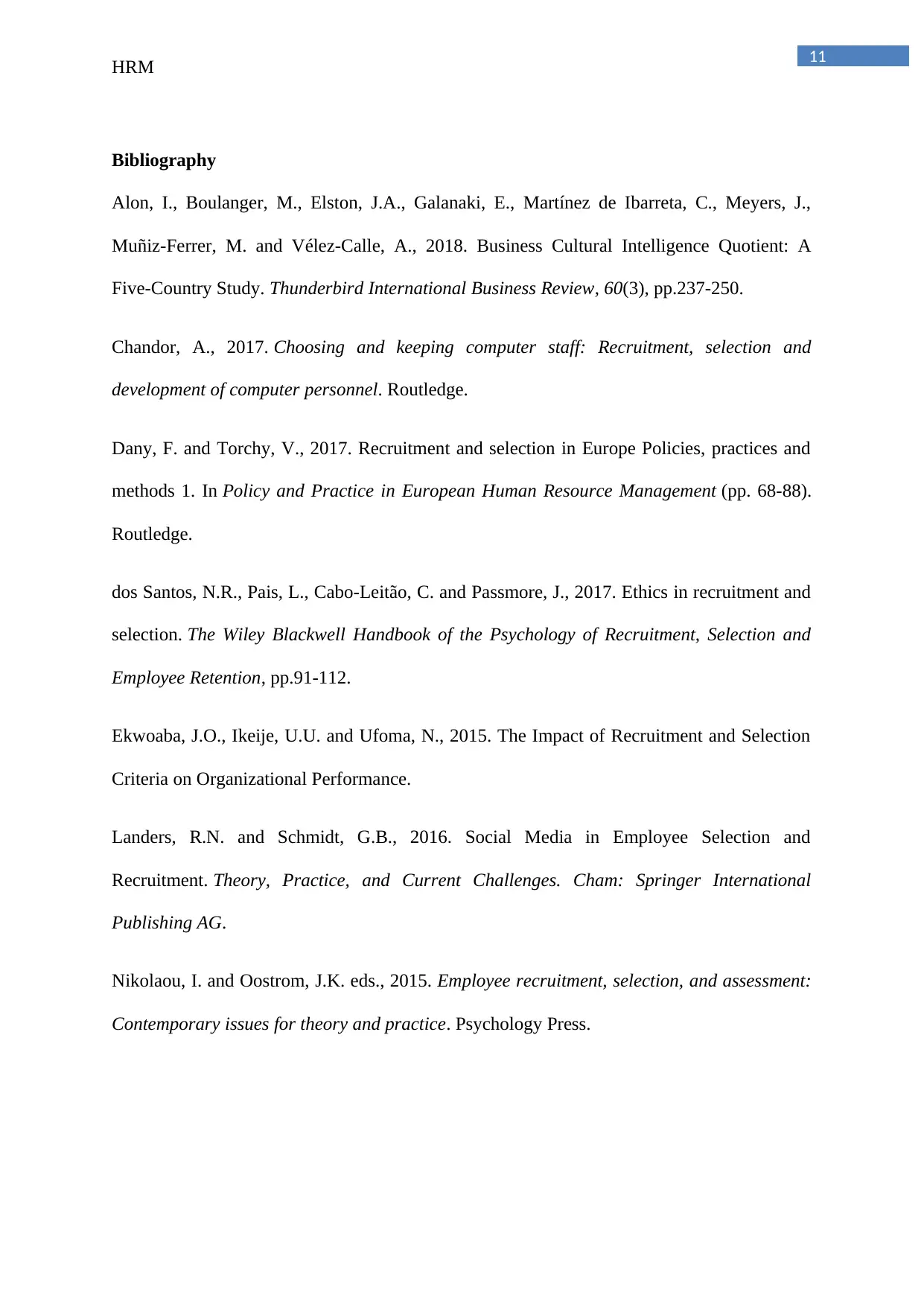
11
HRM
Bibliography
Alon, I., Boulanger, M., Elston, J.A., Galanaki, E., Martínez de Ibarreta, C., Meyers, J.,
Muñiz‐Ferrer, M. and Vélez‐Calle, A., 2018. Business Cultural Intelligence Quotient: A
Five‐Country Study. Thunderbird International Business Review, 60(3), pp.237-250.
Chandor, A., 2017. Choosing and keeping computer staff: Recruitment, selection and
development of computer personnel. Routledge.
Dany, F. and Torchy, V., 2017. Recruitment and selection in Europe Policies, practices and
methods 1. In Policy and Practice in European Human Resource Management (pp. 68-88).
Routledge.
dos Santos, N.R., Pais, L., Cabo‐Leitão, C. and Passmore, J., 2017. Ethics in recruitment and
selection. The Wiley Blackwell Handbook of the Psychology of Recruitment, Selection and
Employee Retention, pp.91-112.
Ekwoaba, J.O., Ikeije, U.U. and Ufoma, N., 2015. The Impact of Recruitment and Selection
Criteria on Organizational Performance.
Landers, R.N. and Schmidt, G.B., 2016. Social Media in Employee Selection and
Recruitment. Theory, Practice, and Current Challenges. Cham: Springer International
Publishing AG.
Nikolaou, I. and Oostrom, J.K. eds., 2015. Employee recruitment, selection, and assessment:
Contemporary issues for theory and practice. Psychology Press.
HRM
Bibliography
Alon, I., Boulanger, M., Elston, J.A., Galanaki, E., Martínez de Ibarreta, C., Meyers, J.,
Muñiz‐Ferrer, M. and Vélez‐Calle, A., 2018. Business Cultural Intelligence Quotient: A
Five‐Country Study. Thunderbird International Business Review, 60(3), pp.237-250.
Chandor, A., 2017. Choosing and keeping computer staff: Recruitment, selection and
development of computer personnel. Routledge.
Dany, F. and Torchy, V., 2017. Recruitment and selection in Europe Policies, practices and
methods 1. In Policy and Practice in European Human Resource Management (pp. 68-88).
Routledge.
dos Santos, N.R., Pais, L., Cabo‐Leitão, C. and Passmore, J., 2017. Ethics in recruitment and
selection. The Wiley Blackwell Handbook of the Psychology of Recruitment, Selection and
Employee Retention, pp.91-112.
Ekwoaba, J.O., Ikeije, U.U. and Ufoma, N., 2015. The Impact of Recruitment and Selection
Criteria on Organizational Performance.
Landers, R.N. and Schmidt, G.B., 2016. Social Media in Employee Selection and
Recruitment. Theory, Practice, and Current Challenges. Cham: Springer International
Publishing AG.
Nikolaou, I. and Oostrom, J.K. eds., 2015. Employee recruitment, selection, and assessment:
Contemporary issues for theory and practice. Psychology Press.
⊘ This is a preview!⊘
Do you want full access?
Subscribe today to unlock all pages.

Trusted by 1+ million students worldwide
1 out of 12
Related Documents
Your All-in-One AI-Powered Toolkit for Academic Success.
+13062052269
info@desklib.com
Available 24*7 on WhatsApp / Email
![[object Object]](/_next/static/media/star-bottom.7253800d.svg)
Unlock your academic potential
Copyright © 2020–2025 A2Z Services. All Rights Reserved. Developed and managed by ZUCOL.




